

|

|
The History of Ednam. The aim of this web site is to provide information about this old and very interesting village since its origin in the late 11th Century. Not being a historian I cannot lay claim to having all the details and nuances of the various centuries but I hope that readers of this site will find something for all tastes. My research has been, of necessity, restricted but I will try to ensure its accuracy. If anyone would would like to add to this site or provide me with, stories, information or pictures I should be very grateful. The Reverend Burleigh in his book tells us that "The people (of Ednam) are typical border people, just like those in any of the other towns". They are a cautious people, prone to under statement. In Ednam the church and the school played a large part in their lives. The first schoolmaster was a Robert Brown in 1620 though there was probably a school here soon after the Reformation. From 1620 on there was always a schoolmaster here, but as in all professions today there were good and bad schoolmasters. Yet Ednam has an impressive record for nurturing talent and have produced some famous people. It is remarkable that for such a small village (and it was never a large place) Ednam has proved capable of providing good education. It is striking that so many of the people from Ednam were poets. |
|
Introduction Prior to 1097 the village of Ednam did not exist. The entire area was a wasteland. This was during the reign of King Edgar who was the fourth son of Queen Margaret and King Malcolm (Canmore). He had to fight to become king and so had to depend on the loyalty of his followers and soldiers. As a reward for such services he gave areas of land to his valued soldiers and friends. One such person was Thor Longus and to him King Edgar donated the lands of which the present village was part. These lands, at that time were extensive and stretched both north and south of the river Eden and from the present village down as far as the River Tweed at Edenmouth. Although the area in 1097 was an unihabited waste land it enjoyed a sheltered position and had the advantage of being sited on the banks of the River Eden. |
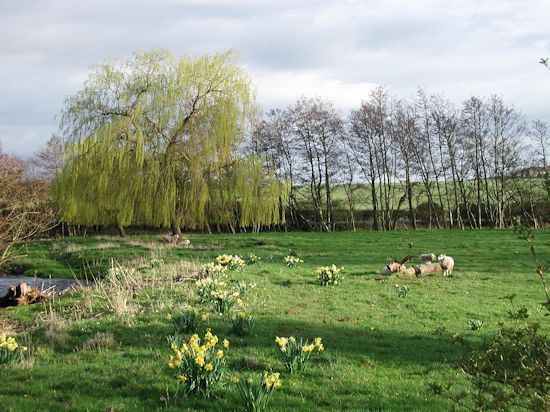
|

|
When the king gave lands to his subjects a Barony was created and the person to whom the land was given was called the laird. At first this area was called Edinham or Edenham or Ednaham. The ending, "ham", which is common to many villages in the Borders region means "settlement" so when Thor Longus created an inhabited place on the River Eden the name Edinham was appropriate - the settlement on the Eden. This system, whereby lairds owned land, became known as the Feudal System. The position of Laird had many rights and priveleges. The Laird had the right to settle disputes, to sit in judgement and even had the right to inflict the death penalty if the occasion arose. For this purpose each barony had a "Gallows Tree". The Laird was, indeed, a powerful person. This is how the settlement of Ednam began and the old Celtic way of life changed. Areas of land were called parishes and Ednam is the first parish to be registered in Scotland. As Thor Longus developed his Barony people began to settle there. The previously nomadic shepherds who came to the region because of its sheltered position eventually set up their tents permanently.Over the centuries the parish is reported to have consisted of about three to six hundred inhabitants. In the census in 1851 the population of the Parish was 650 and that of the village itself was 162 with 41 houses being inhabited and 2 uninhabited. The 2001 census shows the population of the village as 140. |
|
This gift of land to Thor Longus ( who was probably a norseman) was required to have a Charter All such gifts had charters,and the above shows the details of this charter which Thor Longus made to Durham and which is preserved in Durham Cathedral. It records that when he came to Ednam the area was uninhabited and that he lived on the land, reclaimed it, and laid the foundation for the church which he and the king dedicated to St. Cuthbert. He drained the land and made it a suitable place for people to live. The people who came to work in this region would previously have moved round the country with their animals but through time, as they worked for Longus,they became loyal to him as he had given them a living and a home. In turn Thor was loyal to the king so for everyone it was a comfortable arrangement. It does not appear that Longus had any family so he must have lived a fairly solitary existence. He lived and worked in Ednam for the rest of his life and is reputed to have been buried here. There appears to be some uncertainty about the actual place of burial. One theory is that he was not buried in the Church yard but on a hill a little further from the village and overlooking it. As three stone coffins were discovered above the village some centuries later that theory was thought to be correct. However other "authorities" maintain that a person of Thor Longus' calibre would most certainly have been buried in the church and as the existing church stands on the site of the original it can be argued that Thor Longus still rests there. If anyone can clarify this point without any doubt them I shou;d be glad to have that information. |

|

|
From the time of Thor Longus as the first laird, there is a record of all the lairds of Ednam 1165 the next laird was William the Lion |
|
The Laird First of all the laird had to make his new land habitable. and he had to create work for the people. His first building was the church and since 1105AD the church in Ednam has occupied that same site although there have been severeal buildings.The Church was dedicated to St Cuthbert and became the focal point of the village. The building of a mill must have followed soon after the church and the Minister and the Miller were very important peeople in the community.The first laird,Thor Longus, brought people to this area of uninhabited wasteland. He wanted to drain and reclaim land, to build a church and to provide industries where people could earn a living. Although there is no mention of a mill here at first, we can assume that, in a rural area, when a barony was created the laird had the right to build a mill. We do know that there was a mill in 1128 as King David, in a charter, gave certain rights regarding the mill to the Monks of Kelso when they moved there from Selkirk. The Laird was he head of the community with, on his one hand the minister, and on his other the miller. |

|
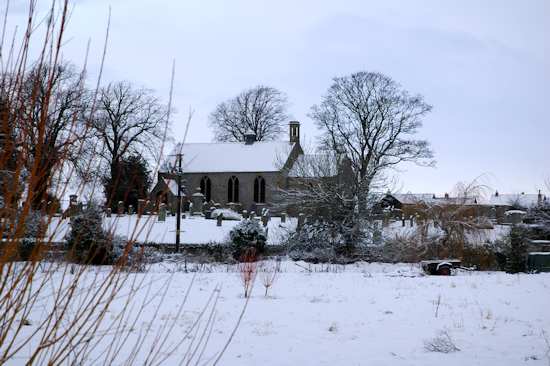
|
The Minister Probably the Minister was the second most important person in the area after the laird. He, of cours, cared for the spiritual needs of the Parish. He administered the sacraments and had a great influence on the people. He lived in the manse and in later centuries,once Prsbytarianism was established, he had regular contact with the Presbytery. A list of Ministers can be found below. |
|
The Miller The course of the old lade (still clearly seen today) from the West Mill to the river |
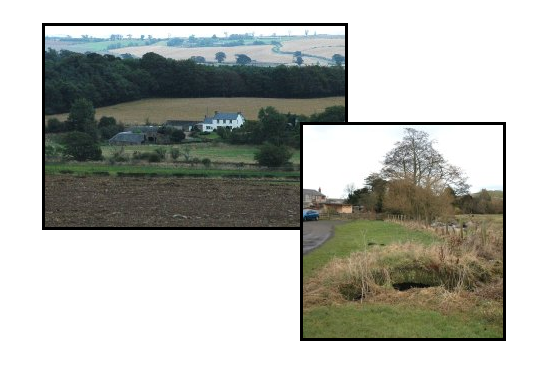
|
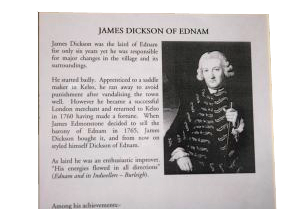
|
Walter was succeeded by his son William de Edenham 1314 It became evident that Robert had chosen unwisely and when Robert the Bruce overcame the English and became king of Scotland all estates of those lairds, who had sworn oaths, were forfeited to the crown. Ednam was given by King Robert to his daughter Marjorie Ednam in due course passed to Marjorie's son Robert who sold it to a Sir Robert Erskine. |
|
David 1413, James 1426, John 1458, John 1482, James 1496 the 6th Edmondstoune. On June 6th June 1496 the English attacked this area of the borders and destoyed the great steeple and tower of Ednam, the castle at Stichill and burned Ednam. Ednam was rebuilt but not the tower and steeple. 14th laird Andrew married Isabel, daughter of Sir Alex Don. 1760 was succeeded by James the 17th and last of the Edmondstounes. He was laird for only one year. Estate at that date consisted of village, 3 farms (Cliftonhill, Houndridge and West Mains). In 1761 he sold Ednam which had been in the family for 4 centuries to a James Dickson. 1765 James Dickson was born in Stichill in 1712 and had been an apprentice saddler in Kelso before leaving (under a cloud of suspicion) to make his fortune in London. |
|
James Dickson made his fortune and returned to Kelso where he build a house which he named "Havannah House". Later he bought Ednam but continued to live in Kelso. He changed the name of his house to "Ednam House" which today is a hotel. Dickson was the first laird to live outside Ednam. Although he did not live on his lands he made many improvements eg he drained the lands,rebuilt his village,for the first time covered the roofs with red pantile tiles, built another mill and brought brewing as a business to the village. He also had great dreams of building a canal to link Kelso and Berwick but lack of financial backing prevented this. He died in 1771 at the age of 59 and is buried in Ednam church yard. As he had no children s two nephews inherited his estate. Links |

|
|
James Dickson´s grave in Ednam Church Yard The inscription reads: Here lies James Dickson of Edenham, late merchant in London and representative in Parliament for the district of Peebles who died X1V November MDCCLXX1 in the L1X year of his life. 1904 Ednam, a new laird, Sir Richard John Waldie Griffith of Henderside, took ownership of Ednam and as he was a native of the area. His father Sir George Richard Griffith had married the heiress Maria Jane Waldie of Hendersyde and the family had added the name "Waldie" to their surname in 1865. So, to this new Laird, Ednam was his home.. He bought Ednam in 1904 for £52000. He later was involved in a legal dispute abroad and lost his case. His third wife Lady Maude had acted as his defence in court proceedings the loss of which left him bankrupt. |
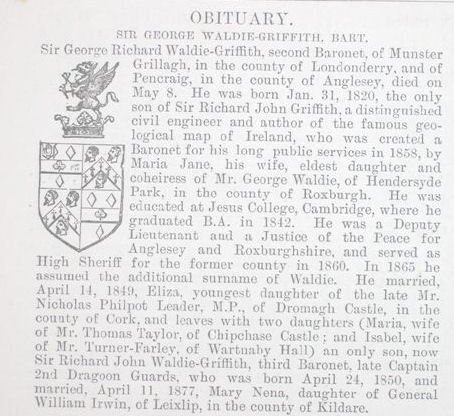
|
Obituary of Sir George Griffith There is a brass plaque inside the church in memory of Lady Griffith and reads "In memory of Lady Frances Griffith beloved wife of Colonel Sir Richard Waldie Griffith". |
|
James Thomson Born in Ednam Manse in 1700 to an Ednam family as his grandfather had been gardener to the Laird (probably the 15th of the Edmondstoune lairds). His family moved from Ednam to Southdean when James was still a baby and lived there for 15 years until the death of his father. James as a young boy,probably attended Jedburgh Grammar since Southdean is only 8 miles from Jedburgh. He then went on to Edinburgh University and as his father had died his mother had to put him through university on her own. He started off studying Divinity but while there changed his mind and decided to follow a career in literature. Even though this was a much less secure career move his mother supported him. He had always been interested in poetry and wrote his own. Influenced by the works of one of his tutors he wrote "Winter" in 1725........Click Here for more |
 |
|
Dr Adam Walker is a PhD candidate in the Department of English Literature at Harvard University, where he focus on English Romantic poetry. His published work has appeared, or is forthcoming, in The Coleridge Bulletin, North Wind: A Journal of George MacDonald Studies, The Journal of Romanticism, and The Journal of Scottish Studies. He has also reviewed books for The Journal of Romanticism, The Coleridge Bulletin, and The Wordsworth Circle and has presented research at the Northeast Modern Language Association Conference, the Biennial Coleridge Conference, the Annual Wordsworth Conference, the British Society of Eighteenth-Century Studies, and elsewhere. As Teaching Fellow at Harvard, he has taught courses on rhetoric and composition, Shakespeare, American poetry 1620-1850, and global lyric poetry from Sappho to Taylor Swift. In this video he discusses "Winter" by James Thomson. You can find out more about Dr. Walker Here and Here |
|
Actress Julia Watson reads extracts from 18th Century poet James Thomson´s Summer, one of his series of The Seasons. Julia read this at the Friends of Richmond Park´s Poetry and Prose in Richmond Park event, June 2015. |
|
|
This was the first of his work called "The Seasons" and he completed the other three in 1730. He is also remebered for his composition of "Rule Britannia". In his memory a column has been erected on a hill above Ednam and is visible on the sky line from the village and from the Kelso Road. Now, in 2008, there are plans afoot to provide a footpath from the Kelso/Ednam road up to the monument as the present access road is difficult. |
|
William Hooper − 17 June 1742 to 14 Oct. 1790 William Hooper, one of North Carolina´s three signers of the Declaration of Independence, foremost Patriot leader, writer, orator, attorney, and legislator, was the oldest of five children of the Scots divine, the Reverend William Hooper (1704 ´ 1767), second rector of Trinity Episcopal Church, Boston, Mass. and Mary Dennie Hooper (b. ca. 1720), daughter of Boston merchant John Dennie. He was the grandson of Robert and Mary Jaffray Hooper of the Parish of Ednam, near Kelso, Scotland. An unusually delicate, nervous child, William was at first painstakingly taught at home by his father, himself a classicist and orator of some note, educated at the University of Edinburgh. At age eight, the boy was sent to the Boston Public Latin School where he worked so hard under headmaster John Lovell, a celebrated disciplinarian and staunch Loyalist, that at fifteen he entered the sophomore class of Harvard College on 7 Oct. 1757. He was graduated A.B. in 1760 with marked distinction in oratory, surpassing, it is said, even his father in that field. Although the Reverend Mr. Hooper had hoped that his oldest son and namesake would enter the ministry, William´s own inclination led him to law; and in 1761 his father allowed him to study under the brilliant James Otis, famed for his knowledge of common, civil, and admiralty law. Various Hooper biographers have stated that Otis's fiery stands for colonial rights indoctrinated the young Hooper. |
|
|
|
William Wright William Wright Born in Ednam in 1782 - 8th of 13 children of an "orra-man" (an odd job man) Theirs was a poor family and William was a cripple. He left Ednam on only three occasions in his life. His father died when he was 19 and his mother looked after him until she died when he was 30. He must have been a lonely, solitary man as he had to depend on others to move him about. When the weather was warm enough someone would take him into the churchyard where he was happy to sit until evening and it was here that he wrote his poetry. The winters must have been very trying for him as he was then confined to his house and he had very few friends. However he had three good friends , the Laird, Sam Robertson the brewer, and Ms Anna Waldie who took care to see that he was looked after. It was she who persuaded him to have his rhymes sent to the printer and they were published in 1819. Some of his verses are: |
|
Andrew Brotherton Andrew Brotherton was born in 1834 in Eccles Shiel and moved to Ednam very shortly after his birth. He always considered himself an Ednam man. He started school in the village while John Gibson Smith was the schoolmaster. Andrew Brotherton was highly intelligent with great potential but was not ambitious. His father was not a skilled man and did not recognise the opportunities which lay ahead for his son. Andrew was a gifted pupil and loved nature. Although he did not write verse his love of nature was in a way a form of poetry. He worked in the village as a gardener so that he would have time for his hobbies of nature study and bird stuffing. He was an expert botanist and his extensive knowledge was recognised by other experts in science. Friends also recognised his talents and helped him to obtain a shop in Kelso where he could carry on his bird stuffing. Professor Williams offered him a post lecturing to students on botany as related to Veteninary Science. Professor Dickson offered him a post as Keeper of the Herbarium in Edinburgh. Both posts he declined. He did, however, became Curator of Museums at Berwick. Kelso and Floors and corresponded with many leading scientists. He wrote many articles with one of particular significance in overcoming the disease destroying salmon in the area at that time. Another of his publications is "Notes on Rare and Uncommon Wild plants found near Kelso" |
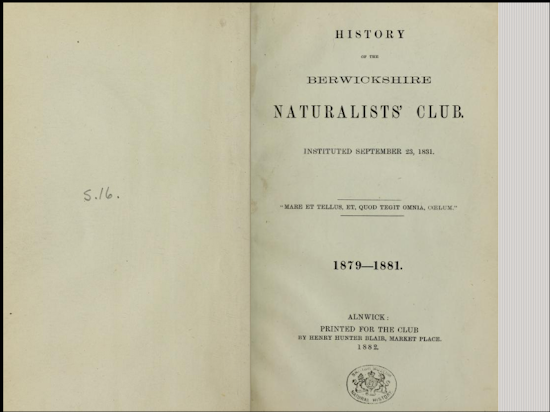
|
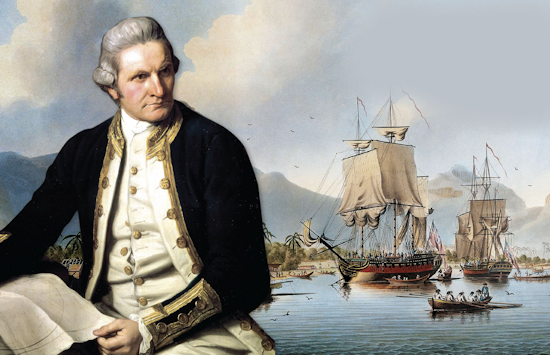
|
Captain James Cook Another famous person with paternal links to Ednam is Captain James Cook the famous explorer. Ednam records show that a John Cooke paid a Hearth Tax in Ednam in 1691 and that 2 years later a John Cook married a Jean Duncan in Ednam Church. 70 years later their grandson James Cook, who was born in 1728 in Cleveland, Yorkshire, landed in what was to become New South Wales, Australia. The 20th century has produced a famous banker. Sir William Purves was born in 1931, educated in Ednam where his mother Mrs Ida Purves was schoolmistress of Ednam Primary School form 1040 - 1963. Sir William Purves has retired and now lives in London. William Purves 1931 Ednam, over the centuries, has nurtured many people who have left a lasting impression on our world. Even today this trend continues and last century a famous banker, William Purves, born 1931, began his education in Ednam. His mother, Mrs Ida Purves, was schoolmistress of the village school. He is now Sir William Purves and a plaque sited in the village hall, when it was built in 2000 pays tribute to him. He now lives in retirement, in London. |
|
The Lyte Family Henry Francis Lyte was born in ´The Cottage´, a property owned by the brewer in Ednam. He was the middle son of Thomas Lyte, whose ancestral home, Lytes Carey Manor in Somerset had been in the family from 13th century until the late 18th century. His father had sold his commission in the army and with Anna Maria Oliver had come to Scotland. Their three boys were born in the Borders with the two younger ones being born and baptised in Ednam. The family lived in Ednam for about eight years before moving to Northern Ireland. It was there that the family broke up with his mother and younger brother returning to England and his father and older brother moving to Jersey. Henry Francis, of outstanding ability, was educated at Portora School and Trinity College. In Ireland he remained in the care of the family of the kindly Dr Burrows, Headmaster of Portora school. After his ordination as a minister he served in several parishes before going to Brixham, in England where he had charge of All Saints Church for 23 years. He was a prolific writer and a talented speaker. Besides his many publications he is remembered as the author of “Abide with me”. Although he never returned to Scotland he always considered the Borders to be his homeland as his poem, “On my Native Land” testifies. For many years ill-health plagued him and while convalescing in France he died and was buried in Nice. A plaque in Ednam church-yard commemorates his life. |
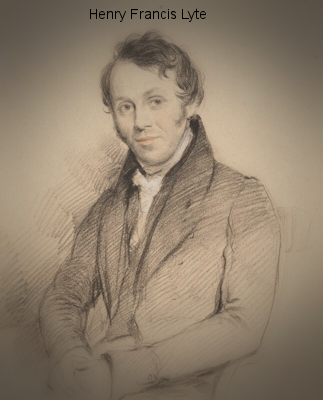
|
|
Some time ago I posted a news item about a descendant of Henry Francis Lyte who was listed in a website which I came upon by chance. Mr Bradley Dilling from Georgis, USA is that person and since then we have corresponded regularly by email. He has a great interest in Scottish history he is keen to learn as much as possible about the Scottish Borders and his Scottish ancestors. Reverend Tom McDonald has written to Bradley with details of the Parish of Kelso North and Ednam. He included a copy of Rev Donald Gaddes´ book ´One of Zions Gates´. Bradley tells me how pleased he is to have heard from Rev McDonald and how much this contact helps him to have a ´feel´ for the area. Like his ancestor he seems to be drawn to Scotland.It is to be hoped that,when he does manage to visit us, whenever that may be the knowledge he is now acquiring about past and present life in this beautiful part of Scotland will help him to feel part of this Borders community and enjoy the welcome which I know will be waiting for him. Of course he has now written by e-mail to the Reverend Tom. |
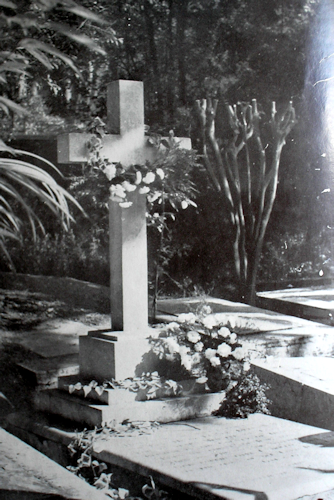
|
Grave in Nice After his death his daughter Anna Maria Maxwell Lyte (then Mrs Hogg) had some works published and which she called "The Remains of the Reverend H. F. Lyte". Ednam honoured him with a plaque on the parapet of the bridge from Kelso into the village. However folllowing a road accident on the bridge in 2005 the old plaque which was very worn was removed. A new plaque, as part of the celebrations for 900th anniversary (October 2005) of the parish has been erected inside the Church grounds, just opposite the Garden of Remembrance |
|
Bradley Dilling − Friend of Ednam In the summer of 2008. Bradley Dilling came to Scotland for two and a half weeks. During that time with us he spent some days in Edinburgh and also enjoyed a visit to the Highlands and Orkney. We spent four days in Ednam where he attended the Sunday morning service in Ednam Church which meant a lot to him as two of his ancestors , Henry Francis and his younger brother George, were baptised there. Henry Francis must also have attended Ednam school as the family did not leave Ednam until Henry Francis was seven years old. While in Ednam the present owners of Henry Francis' birthplace kindly invited Bradley to see the house. He has left with a treasured photo of himself taken inside the house, in the part which was the original "Cottage". As Bradley is a professional photographer he has a great many beautiful photos of Scotland, which he tells me he still looks at regularly. One of his favourite places is Inchcolm Abbey. On our visit there I found it difficult to ensure that we did not miss the boat back to South Queensferry. Orkney is another island which he hopes to visit for a longer period of time. Bradley tells me that he had a wonderful time in Scotland and found the people very hospitable (I think we all lived up to the reputation of being a welcoming people). Bradley hopes to return for another visit ansd see more of our beautiful country. Haste ye back, Bradley |

|
|
ANDREW BROTHERSTON 1834 Andrew Brotherston was born in 1834 in Eccles Shiel and moved to Ednam very shortly after his birth. He always considered himself an Ednam man. He started school in the village while John Gibson Smith was the schoolmaster. Andrew Brotherton was highly intelligent but as he lacked ambition he never reached his full potential. Andrew was a gifted pupil who loved nature and worked in the village as a gardener so that he would have time for his hobbies of nature study and bird stuffing. He was an expert botanist and his deep and wide knowledge was recognised by many experts with whom he corresponded but he always declined posts of responsibility which were offered to him. He wrote many articles with one of particular value in overcoming the disease destroying salmon in the area at that time. Another of his publications is "Notes on Rare and Uncommon Wild plants found near Kelso" |
|
Richard Waldie Griffith 1850 The Waldie family was an eminent Borders family from Hendersyde Park, Kelso Richard Waldie-Griffith was born in 1850, the only son of Sir George Griffith − born 1820, (whose father Sir Richard John Griffith married Maria Jane Waldie, an heiress of Mr. George Waldie of Hendersyde. The family in 1865 added the surname Waldie to their name of Griffith. In 1849 Sir George married Eliza, daughter of Mr Nicholas Philpot Leader MP in County Cork. They had 2 daugters and one son, Richard who on his father´s death became Sir Richard. Sir Richard was born in 1850 and in 1877 married Mary Nena, ( she died in December 1916) daughter of General William Irwin of Leixlip, County Kildare. In 1904 Sir Richard bought the Estate of Ednam from William Humble, Earl of Dudley for the sum of £52000 thus becoming the Laird of Ednam. It was largely due to Sir Richard´s generosity that Ednam had a spacious site on which to build its new school. With the donation of the land and a sizable financial input to the cost of the building, the school, which houses today’s pupils, was built and opened in 1911. |

|
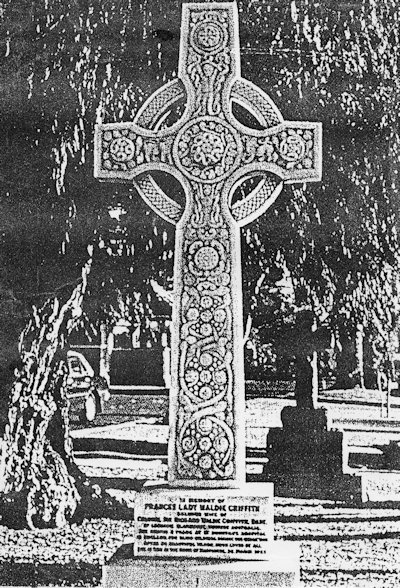
|
Obituary of Sir George As Sir Richard had no children from any of his three marriages on his death the family became extinct as the following extract from records shows. of Munster Grillach,Londonderry A lady called Robyn Doohan, from Australia who is researching the life of Sir Rihcard's second wife, Frances has sent me information about that lady. The plaque in Ednam Church is in memory of Lady Francis and I now have photos of her grave and headstone in Australia. The inscription on her actual headstone is the same as that on the plaque in Ednam church. I also have a copy of the announcement, in the Australian paper, of the engagement in 1922, of Sir Richard and Frances. Argus (Melbourne, Vic.) Saturday 4 November 1922, page 24. News 546 words Between Colonel Sir Richard Waldie Griffith, Bt., 4th King's Own Scottish Borderers, of Hendersyde Park, Kelso, Scotland, and Miss Frances do Burgh Griffith, daughter of Mr. and Mrs. Edward Griffith, of Collie, Western Australia. Mr. Edward Griffith has two brothers in Victoria - Dr. C. A. Griffith of Berwick, and Mr. L. D. Griffith, manager of the State Savings Bank, Hawthorn. Lady Frances died in 1925 so the marriage was a short one |
|
Memorial Plaque in Ednam Church Below are details of Frances´ war service in London Summary of Service: Served at St Dunstan's Regents Park Auxiliary Hospital from 27.11.17 |

|
|
I have a request from another reader who lives in the USA and I would welcome any information regarding relatives of the Waldie-Griffith family so that I can pass it on. Mr Neil Webner writes "Dear sir, I note on your interesting web page a reference to a lady research the genealogy of the Waldie-Griffith family. From my very preliminary research, it appears that the information on the family given to you is accurate. I have the scroll from 1858 in which Richard John Griffith was named baronet. It is encased in a beautifully preserved leather bound case and includes a wood carving of the Griffith seal. I would love to see that a rightful heir has this in their family heirloom collection." |

|
The Waldie-Griffith grave in Ednam Kirkyaird |
|
Inscription on grave in Ednam |
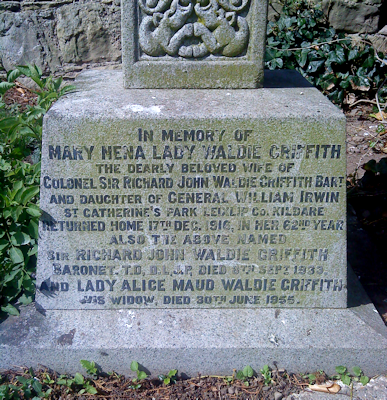
|

|
The Schoolhouse, Ednam The white building was the schoolhouse while the adjoining building was the school (photo taken in 2005 from behind the church) There is now a new school which was built on the other side of the road from Ednam to Stitchill and opened in 1911. John Gibson Smith was the schoolmaster in Ednam from 1834 unti 1864 John Gibson Smith, though not a native of Ednam, (he was born in Biggar in 1816) came to Ednam as its schoolmaster in 1834 where he quickly earned the respect of the children and their parents. He was an excellent teacher and, as his predecessor had been a failure, the community welcomed this strict but popular newcomer. His reputation was such that some 20 to 30 children chose to travel from Kelso daily to attend his school. He had two great hobbies – gardening and poetry – about both he was very knowledgeable. He is reputed to have been a cheery, happy man yet many of his poems are rather sombre and belie this image of him. In 1862, "The Old Graveyard," a 240 page volume of his poems was published In the 1851 census he is listed as "widower". Research indicates that he married Wilhelmina Thomson in 1834 (the year in which he became Ednam's schoolmaster, and sadly Wilhelmina died in 1841. Although only aged 18 at the time of his appointment he was already highly educated and had held positions of responsibility. In 1851 he married Mary Waddell (his first wife died in 1841) from Oban and they had a large family of 8 children. Some of his children became teachers. Because of ill-health he, and his family, emigrated to New Zealand in 1864 where he wrote much more poetry in his spare time. He is buried with his wife Mary at Eastern Cemetery, Invercargill, New Zealand. |
|
Because of ill-health John Smith resigned as schoolmaster and the family emigrated to Invercargill in New Zealand .The eight children - John Gibson Smith born in 1852; Christian Macdonald Smith 2/5/54; Mary Ann Smith 7/2/56; Jane Graham Smith 6/9/57; James Waddell Smith 23/6/59; David Mcrae Smith 1/12/61; William Chrichton Smith 2/1/64. Seven of his eight childrenof were born in Ednam. Their last child, Margaret Jamieson Smith 11/12/66 was born in New Zealand. Many of his children became teachers also. In New Zealand he continued to wrie much more poetry in his spare time. He is buried, with his wife Mary, at Eastern Cemetery, Invercargill, New Zealand. The School Log This is a selection of some of the entries and these can be read in full by visiting the excellent web site prepared by the modern Ednam students. 1873 28th November 133 scholars. One of my pupils, by name Bowmont Weddell, has been appointed a pupil Teacher in the Duchess of Roxburghe's School and has accordingly left this school |
|
1874 25th December Monday being the shortest day, the pupils by a flank march debarred me from getting into school in the afternoon - hence the half holiday. Apparently to make amends for their cruel treatment to their teachers on that day, they presented their teachers with handsome and costly Xmas presents on Thursday. 1875 23rd July The Annual Excursion of pupils to Hendersyde Park came off to-day. There were 100 pupils present. Carts were kindly provided for the occasion by Messrs Ross of Newtonlees, Roberton of Harpertoun, Rennie of Edenmouth Burn, Ednam. The Scholars experienced much kindness at the hands of Mr and Mrs Waldie Griffiths. 1879 9th June 20 new pupils enrolled but most of them, in fact all of them, without intelligence and very deficient in every respect. It will take a year's work to bring them up to those lost at the Whitsunday "flittings" and whose place they fill. Two half holidays, - one on Tuesday afternoon and other on Friday afternoon, the former being day of Inspector's visit, and the latter being Kelso Hiring for Farm Servants. |
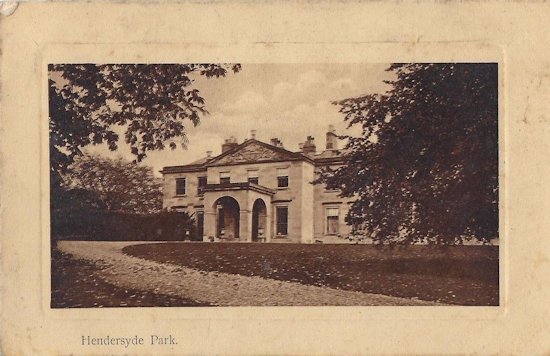
|
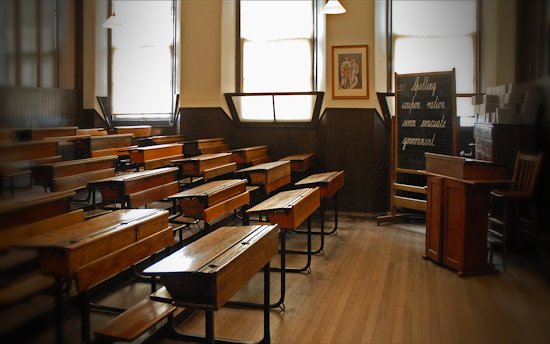
|
1879 9th June 20 new pupils enrolled but most of them, in fact all of them, without intelligence and very deficient in every respect. It will take a year´s work to bring them up to those lost at the Whitsunday "flittings" and whose place they fill. 1882 5th May Lily, my youngest child, lying seriously ill and school conducted on Friday 1882 8th May School standing about 2 inches deep with water, caused by a remarkable rainfall yesterday (Sunday) and the pipes were not sufficient to carry the water off. The door-step being too low the water found its way into the Schoolroom and Class-room. The floor today was so wet that we found it necessary to dismiss the Scholars. Measles have broken out in epidemic form and most of the Scholars who have not had them before are now lying therewith. 1882 15th May Lily, my youngest child, died today, and made a sad blank in School and house. |
|
1885 1st April Examination in Bible History, etc. 14 pupils repeated correctly Christ's sermon on the Mount and each of these received a book as a prize from Mr Roberton, Chairman of the Board. 1887 28th July The girls in Standard V1 Arithmetic very superior to the boys. The former have got their work up but the latter are still in comparative darkness. 1896 21st November Attendance keeping up tolerably well. The Scholars work agreeably and are anxious to please their teachers. It is seldom necessary to have recourse to corporal punishment - never for discipline, - occasionally for badly prepared lessons. NOTE: Mr Pringle had bought Eden House from the Earl of Dudley and lived on in Ednam after his retirement in 1905. He died in Eden House in 1927 and is buried in the "Kirkyaird" |

|
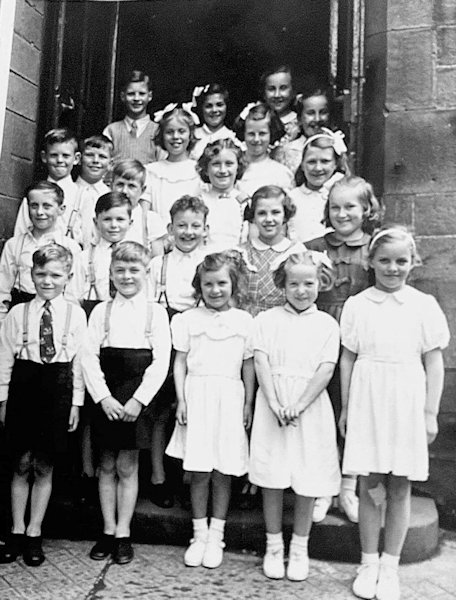
1950 ´s Ednam Primary School children |
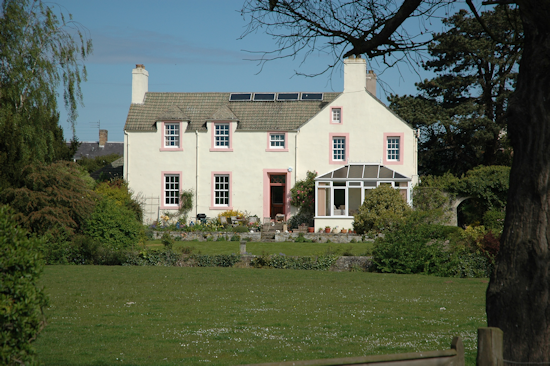
|
Eden House Eden House occupies a prominent position near the river and overlooking the area. It is curently a private residence. The inscription reads: erected by David Pringle in loving memory of his daughter Lily Alice J. Pringle who died at schoolhouse Ednam on 15th May 1882 aged 5 years. Also of his wife Alice Fisher Pringle who died at Eden House Ednam on 13th April 1920 aged 73 years and also the above named David Pringle who died at Eden House on 16th March 1927 aged 87years and who was schoolmaster at Ednam from 1864 - 1905. also their daughter Mary Spence Pringle beloved wife of Frederick Finlayson who died 3rd June 1955 aged 82years and also the said Frederick Finlayson who died 25th March 1968 aged 100years. |
|
The Late John Gibson Smith His funeral service in Invercargill New Zealand The funeral of the late J. G. Smith took place on Friday afternoon, and, although the weather was extremely boisterous, a large number of citizens assembled to pay their last respects to one who had been for so many years a prominent figure amongst them. Old residents, those familiar with the town and its people since it first had a "local habitation and ft name," were represented by not a few faces that have been familiar on its street* for the past quarter of a century and more. The members of the present Education Board, in whose service the deceased had spent the last twelve year* of his life, attended in a body, having adjourned the meeting of that day and closed the offices in order that they and their officials might pay the last tribute to their late treasurer and colleague. The Rev. G. Lindsay, of St. Paul´s, conducted very impressively the simpie Presbyterian service in the house and at the grave, and the coffin was borne from the house to the hearse, and from the hearse to the "narrow house appointed for all living," by Mr James Smith (son), Mr Alex. Lindsay (son-in-law), and Messrs John Neill, J. A. Mitchell, V. B. Scandrett, and Robert Gilmour, old friends of the departed and of the family. After the grave had been filled in, the chief mourners and pallbearers placed upon the little mound a large number of beautiful wreaths and floral devices, the gifts of friends, and that had previously graced the coffin — a befitting conclusion to the obsequies of one who had for a long lifetime been passionately fond of flowers, and of every soft and loveable feature of Nature. At St. Paul´s yesterday morning Mr Lindsay took the last verse of the Book of Daniel, and preached therefrom a very appropriate and earnest sermon. In the prayers h« also made special reference to the deceased and to the bereaved family ; while the hymns selected were full of expressions applicable to the occasion, and after the Benediction the choir sang the hymn beginning, "Days and moments quickly flying." At the end of his discourse Mr Lindsay said : — "ln closing I wish to pay a tribute of respect to the memory of the late Mr J. G. Smith. Although for some years past, through declining health, he had not been able to take advantage of the sanctuary services, yet to some of the older members of this congregation his reverent appearance as a worshipper within these walls will be easily recalled. Mr Smith was a man of unblemished character. There was a kind thoughtfulness about his disposition that made him greatly esteemed as a friend. Especially did his literary tastes and ability make his friendship sought after by those who could value the stores of knowledge which he was ever ready to unfold to them in prose or verse. There was a sunniness of temperament and buoyancy of spirit in his nature that showed itself up to the very last.. One could not feel otherwise than cheerful and happy in his company. In these later days his mind often went back te his earlier years ; to the Psalms and Paraphrases and Scripture passages, learnt in the long ago, which he would at times repeat to those about him, One of his last utterances to me was a reference to the Sabbath morning Bible class — an expression of satisfaction with the good attendance. I cannot do better than close this brief reference to our departed friend by reciting a few of his own verses, entitled Unchangeable, Unchanging Thou"
The brightest gem this world contain,
The star that shed their twinkling light
And man his empires rise and fall
When doubts and fears obscure the soul, John Gibson Smith - schoolmaster - Obituary The announcement in another column of the decease of Mr John G. Smith, treasurer to the Southland Education Board, will take many people by surprise, for although he had reached a ripe age yet his wellknown figure was constantly to be seen at his post in the Education Board's office. About a month ago, however, he had to ask for leave of absence in consequence of feeling unwell, and during the past, fortnight he has been confined to his room. The cause of death was rather natural decay than disease. He suffered no pain, and his intellectual faculties were bright and vigorous to the last. In conversation with his medical adviser and an intimate friend a day or two ago he was quoting from Burns and Hogg with a memory as perfect as that of either of his listeners. Mr Smith was a native of Tweedside, and as a boy he made rapid progress at school and soon thoroughly mastered the Greek and Latin languages. To these he subsequently added a knowledge of French, German and Italian. He chose the profession of a teacher, and after occupying various responsible positions he was appointed to the headmastership of the parish school of Ednam in Scotland. This position he filled with the utmost success, and it was only on account of ill-health and at the earnest solicitation of a relative that he vacated it and came to New Zealand. He arrived in Invercargill in l864, and although a stranger in a strange land (for those on whom he relied had left the town) he put a stout heart to a stey brae, and successfully brought up a large family. His first public appointment in this colony was to the mastership of the Longbush school. Here he enjoyed the pleasures of a rustic life to his heart's content. He next received the appointment of secretary to the Southland Education Board on the separation of this district from Otago when the Education Act of 1878 came into force. About six years ago, owing to the great increase of work, he resigned the secretaryship and had since performed the duties of treasurer to the Board. Mr Smith was not unknown in the literary world, having published a work on the Ancient Manners, Customs, and Amusements of the Scottish Borders, and in 1861 he published a volume of poetry which added to the author's reputation. He was a constant contributor to various periodicals in the Home Country and all the poetry which he wrote in the land of his adoption made its first appearance in the Otago Witness, where it was always welcomed by those from his native land. In 1851 Mr Smith married Miss Mary Waddell, eldest daughter of Mr James Waddell, of Oban. He is survived hy his wife and family, all of whom are grown up. Mr Smith rendered good service to the Southlaud Horticultural Society as a committeeman in bygone years, was often a contributor to its exhibitions and frequently fulfilled to the satisfaction of all the arduous duties of judge. The deceased gentleman was to his intimate friends a link between the present and past generations. He remembered the Disruption of 1845 and the memorable clay when the ministers, headed by the Rev. Dr Chalmers, gave up their benefices for the sake of their principles, ami entered the Free Church of Scotland. At this time he was an elder of the Established Church at Ednam. Earlier than this event was the passing of the Reform Act of I83-, which extended the franchise to many of Scotland's yeomanry and citizens. The registration of voters under tiiat Act created a good deal of excitement and interest, and strenuous efforts were made, both by Whig and Tory, to secure the enrolment of the names of those favourable to their respective parties. Mr Smith's name was one of the first enrolled, and he has often interested and amused his circle by recounting the incidents of the first election under that Act. He has now passed away at a ripe old age, leaving behind him, besides his immediate relatives, a large number of friends who sincerely regret his demise. He was a sterling friend, an unassuming educated gentleman, and indeed a grand old man. |
|
The following are copies of a few of entries from the school records around this time. They make fascinating reading and give a very clear insight into the lives of the children in a rural community. The records tell us that there was seldom need for discipline and vever for bad behaviour Last Year in the old building and the excitement can be felt. 1910 25th November Still in the old school and on the old foundations but not for long as the new school which I have just visited will be ready for occupation not later than June. Examined the Junior School, ages from five to eight, taught by Miss Kennedy, on all the newest lines such as Phonic Reading. Thirty-six are on the roll. Children are all alive to the fingertips. |
|
Examined the Senior School taught by Mr McDonald. Forty-nine children on roll, aged from nine to fourteen years. Heard singing lesson including Gaelic, Scottish and Shakespearean songs which form an excellent voice training. Saw children engaged in drawing and painting lesson, the subjects being ivy leaves. Examined the jotters and was greatly delighted with the neatness and intelligence of all the work. Visited the Technical Department of the school. Miss Brownlee teaches the Technical subjects, the business for the day being that of Practical Dairying. There are thirteen on the roll of the Technical Class. Milk was churned and butter was made in a most expeditious, business-like manner. John Burleigh, Minister of Ednam. Note; Ednam was one of the few schools which had its own cow for the purpose of teaching dairying to its students. The long awaited day has arrived 1911 10th November Today the new school was opened by Lord Reay. The weather was favourable and there was a large attendance of the public, many having come long distances. The proceedings began with the singing of the 100th Psalm followed by a prayer by Rev. Burleigh. At the close ´God Save the King´ was sung led by the schoolchildren. There was an opportunity then given to inspect the different rooms, a privilege which was much taken advantage of. The magnificent building was much admired and all were loud in their praises of the generosity of Sir Richard Waldie Griffiths. School was financed by the local council and Sir Richard, and although it is not known how much Sir Richard contributed it was a substancial percentage of the overall cost. The new school opened in 1911 1912 May The following competitions took place recently:- Dairying, Cookery, Laundry, Gardening, Science and Woodwork. The prizes for all subjects were presented by Sir Richard Waldie Griffiths of Hendersyde on the 24th which was celebrated as Empire Day. The following were awarded by the Free Church of Scotland a beautiful Bible and a diploma for the repetition of the whole Shorter Catechism without a mistake:- Violet Robertson, Annie Purves, James Matthews, Bella Graham, Katie Cessford, George McDonald and Maggie Middlemas. 1913 12th December On Monday, Tuesday, Wednesday and Thursday of this week "Julius Caesar" was staged by the scholars before crowded houses. At the close of the performances, the chairman spoke in most complimentary terms of the way in which the children did their parts. 1914 It was agreed that in the event of the school being let for any purpose, the ordinary charges should be 3 shillings per evening, when the school is lighted and 1/6 when the school is not, together with a gratuity to the caretaker. During the Second World War records show that 19 children from Leith Primary School in Edinburgh were evacuated to Ednam and attended Ednam School. Life here must have been very different for those children from an inner-city school. Changes begin in the village In 1896 The Earl of Dudley sold Brewery House (it is now called Eden House) to the Schoolmaster - Mr David Pringle. Mr Pringle continued as head of the school and is buried in the Kirkyard. Although parts of Ednam had been sold off in previous years when debts had mounted it was about this time that parts of the Village changed hands.Eden House (subjects 1) and the Haugh land (subjects 11) on the south bank of the River Eden were sold to David Pringle |
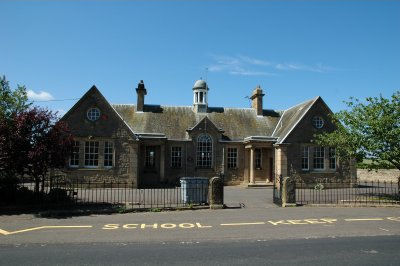
|
The New School opened in 1911 |
|
Mr and Mrs Pringle − The Brewers Site of the Brewery now Eden House Samuel Robertson, brewer in Ednam who died 1807 aged 57years also his wife Margaret Robertson who died ? 1826 aged 66 years also their children David, Archibald, Helen, David and John who all died young. All the above were buried in ground belonging to the Society of Friends in Kelso and were later re-buried here. Samuel, Alexander and David all died abroad. |

|

|
The Brewery Cottage, as it is today, and now known as West Mains House Further research has revealed more about Henry Francis and his family. The Lyte family originated from Somerset where Lytes Cary Manor was the family ancestral home from 13th to the 18th century. Henry Francis' father Thomas lyte, was the youngest of a large family of which only five children survived. Lytes Cary Manor had to be sold because of debts and Thomas Lyte bought a commission in the army but because he was not receiving promotion quickly he sold his commission and, at this point 1790, decided to go to Scotland. Before sailing he met, at a party in London, the young Anna Maria Oliver, whom he had met once before. He persuaded her to sail with him and a servant to Scotland They made their home in Berwick-upon tweed and it was there that their first son, Thomas, was born in 1792. They then lived in Tilmouth until the owner of that property required it and it was then that they rented "The Cottage" belonging to the Ednam brewer, Mr Robertson in Ednam. Henry Francis was born there on 1st June 1793. His Baptism took place in Ednam Church on June 13th of the same year and is recorded in the Parish records. The third child, George, was also born in Edman in March 1795 and baptised in the village church. In the late 1790s Captain Lyte was working again and posted to Ireland. His family ended the lease of the house in Ednam around 1800 and joined him in Ireland. Henry Francis was educated in Enniskillen and Trinity College |
|
All Saints Church Founded 1815 Henry Francis Lyte became the vicar of this church in 1823 and left a deep personal impression on the town. He lived at Berry Head House, now a hotel, and it was there, from his house overlooking Torbay, when he was very ill that he wrote that very beautiful hymn "Abide with me...." The church is now a memorial to him. Among the many works he had published are; The last of these was published in September 1847 and because of failing health Henry went abroad to Nice in France where he died on 20th November that same year. He was buried in Nice. |
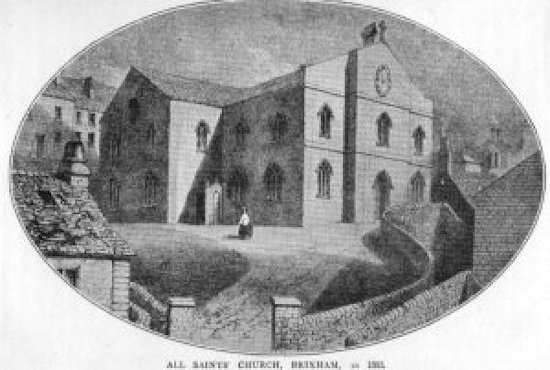
|
 |
The Old Smithy Opposite the Haugh Land |

|
Medical care in the Ednam Area Ednam Parish had a hospital from very early times and although there is no trace of it now it was sited in the field opposite the present race course. It was called St. Leonards and is mentioned several times in the history of the Parish. Its first mention was during the reign of William the Lion in connection with an exchange of land in 1178.In the 14th century again it is mentioned regarding the Master of the Hospital receiving payments. In 1392 King Robert 111 gave the hospital to his sister as a weeding present. Unfortunately it suffered at the hands on the English during theirraids in 1542 and 1544. There are no remains but the site was known as Spitalfield |
|
The Farmers The farmers were the rich men and employed a variety of workers. they employed shepherds, cattle men, ploughmen, field workers, odd job men and servants within the home and in the fields.Women were employed in both indoor and ootdoor farm work. Boys and women usually carried out the day to day runnimg of the farm.The farmers also provided homes (cots or cottages) for their male farmworkers in exchange for their work but it did not end there and there were other conditions. A married cottar,(a hind) was bound to provide the farmer with a bondager (this term was peculiar to the Borders and the North of England and means a female farm outworker). The census of 1851 records the number of hands employed at each farm. |
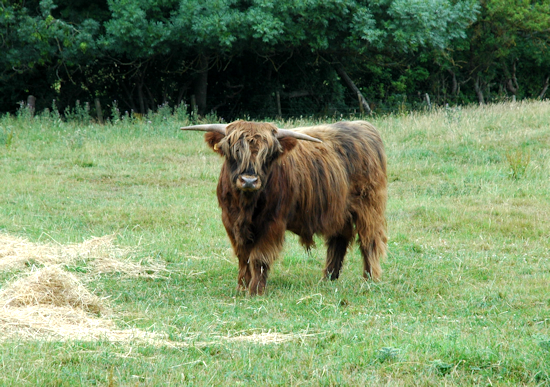
|

|
The Haugh Land between south bank of River Eden and Ednam/Kelso road In this sale there is a condition attached, which is recorded in SS 3877 in Scottish Archives, Edinburgh,namely: a Deed of Condition and Restriction whereby the proprietor(ie Mr Rennie) of Piece of enclosed Haugh land, with River Eden, so far as it runs through same, extending to 5 and 137/1000acres, In Parish of Ednam, 11 described in Disp to David Pringle, recorded 30th June 1896, agrees to the condition that the said subjects shall be used solely for grazing and Declares said condition to be a real burden in favour of the proprietor (named) and her successors as proprietors of House known as Eden House in Village of Ednam forming part of subjects 1 described in disp to David Pringle recorded 30th June 1896". This condition means that the villagers can be assured that that land will remain as a field. Also in 1896 when Eden House was sold water was supplied from a well in the grounds of the old brewery. Earl of Dudley imposed conditions regarding this water and these are available at the Scottish Archives. The Foundation Writ reads that although William Humble has sold the property it had conditions to the effect that the water in the well would belong to Wm. Humble and the owner of Eden House jointly but with the villagers having "at all time" prior claim to the water. The farm at Cliftonhill and the cottages thereon were similarly protected. To this end the weir and lade at the river were excluded from the sale and remained the property of the Earl of Dudley. These conditions still appear in the current foundation writ although the well is no longer in use. A lot has changed since 1896 and home owners no longer need to fetch water. Water was led to Clifton Hill from East Mill in the 1930s |
|
A Gathering in the 1920´s |
|
A Party |
|
During World War Two |
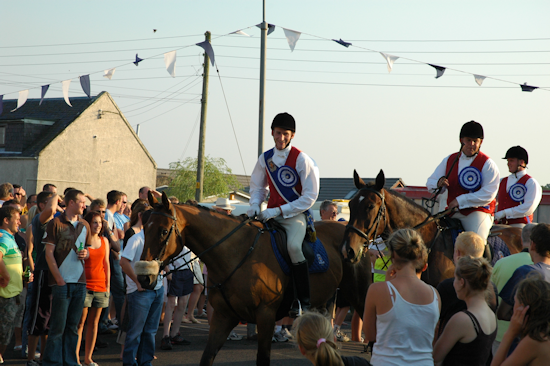 |
Present Day Kelso Civic Week officially started in 1937 by John Scott, baker and Provost of the town so that Kelso could have a Common Riding similar to the other Border towns. Since then, apart from the War years, a worthy Laddie has been selected with his Right and Left Hand Men (the Laddies from the previous two years) to lead his mounted followers in the ride-outs into the surrounding countryside and to the local villages. During a normal year, the Laddie and his followers ride to Heiton, Stichill, Hume and Ednam, Floors, Morebattle and to Yetholm where they meet the Yetholm Principals, the Bara Gadgie and the Bara Manashee. In addition, there are sporting events for all ages, a Fancy Dress Parade, an Exhibition of Paintings, and the Civic Week Ball. A wreath is laid at the War Memorial at the start of the week, and the colours are bussed by four young ladies on the Wednesday. |

|
Summary Life in Ednam was well structured, with everyone having a place in the society. It was reported that there were few disputes in the area so we might assume that by and large Ednam people were a contented people. They were also a busy people with little spare time so they may have been too busy to quarrel either with members of their families or with the wider community. That is not to say that people did not experience difficulties. Floods and storms had to be endured and there are many reports of such. In the latter centuries school records show that on occasions the school had to close because the fields were flooded. Storms uprooted trees and accidents happened when the river was in spate. One of the Lairds who had two daughters and a son suffered a tragic loss when his daughters Mary and Elizabeth were both drowned as they tried to cross the River Eden when it was in spate. |
|
The Church in Ednam − 1105 to present day We know from the records in the Treasury in Durham Cathedral that a church was built in Ednam between the years of 1097 and 1107 and that Thor Longus was the founder. When King Edgar was succeeded by his brother David, Thor Longus, in his charter, wrote to David in 1107 "With the king's help and my own money I laid the foundations" The original foundations are not visible today but are believed te exist under the foundations of the present church.The church was also given an endowment of land as part of the minister's stipend. The boundaries of that land which measured one ploughgate (104acres) are unknown though at the time they would have been clearly defined. Thor and King Edgar dedicated the church to St. Cuthbert and soon the church and its lands were chartered to the Prior of Coldingham Abbey. The religion was Roman Catholicism Because the church of Ednam had extensive, desirable lands other churches began to challenge Ednam's right to them. One such contestant was the Chapel in Nenthorn which began to encroach on these lands. This dispute was eventually referred to the Bishop who ruled as follows: Ednam church was declared the Mother Church caring for Stichill, Nenthorn and Newtown. The chapel at Nenthorn was permitted to have Mass celebrated there three days per week,and on the Nativity of Christ, on the Purification, as well as in Passion week. On St. Cuthbert's Day, however, Mass was to be celebrated in the Mother Church If these conditions were not adhered to the right to have Mass in Nenthorn would cease until the matter was resolved with the Mother Church. Everything was settled and the spiritual needs of the people were served for many years, until 1560, by the Monks. THE REFORMATION The Reformation in 1560 brought radical changes to the church ; the priests left and Masses stopped. It was 39 years later before Ednam had a resident minister again. In the meantime, however, the people were served by men called Readers who often administered to serveral parishes. These readers conducted the weekly Sabbath services and administered the sacraments as required. 1n 1599 the first permanent minister was Thomas Porteous 1617 saw thw arrival of John Clapperton M.A. who was a supporter of the Liturgy and the Bishops. Troubled times followed and when the Covenant was signed in 1638 bishops were deposed and Mr Clapperton was "outed ". King Charles intervened and the presbytery was forced to delay their proposed induction John Somerville M.A. to Ednam and Rev John Clapperton was duly reinstated until 1639 when John Somerville's induction did take place. In 1660 John Somerville and 11 elders were deposed and replaced by Robert Young. Once again Presbyterianism ended. 1668 Adam Peacock was Robert Young's successor although the people still wanted the Covenant. 1683 still in Episcopal tradition came William Speed M.A. 1688 When William of Orange and Mary came to the throne William Speed, realising his term would come to an end decided to leave and for two years Ednam had no minister. Once Presbyterianism was finally established the church in Ednam again had a resident minister. The church had a large input in the running of the community and also in the education of the children. Since the time of the Reformation there was a school in Ednam but there are no records of this school until 1620. The Monks would have kept record but these were lost when the monasteries were destroyed. The minister, together with the schoolmaster, played important roles in the area. Now in 21st Century Sunday Service is still held in Ednam Church though there is no longer a minister resident in the village. Kelso North Parish Church and Ednam have combined and the minister for Kelso, Mr McDonald, serves Ednam Parish. Most of the ministers of Ednam are buried in the "Kirkyaird" but all except three are in unmarked graves. MINISTERS IN EDNAM SINCE 1599 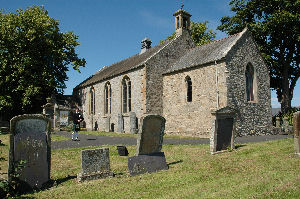
The graveyard is still in use and some headstones date back to mid 18th Century |
1599 |
Thomas Porteous |
1617 |
1617 |
John Clapperton |
1639 |
1639 |
John Somerville |
1660 |
1661 |
Robert Young |
1668 |
1669 |
Adam Peacock |
1683 |
1683 |
William Speed |
1689 |
1692 |
Thomson |
1700 |
1702 |
Baxter |
1722 |
1723 |
Thomas Pollok |
1764 |
1765 |
David Dickson |
1795 |
1796 |
Robert Robertson |
1819 |
1819 |
Joseph Thomson |
1844 |
1844 |
William Lamb |
1877 |
1878 |
John Burleigh |
1924 |
1925 |
William Scott |
1952 |
1952 |
John S McBride |
1969 |
1970 |
Donald R. Gaddes |
1994 |
1994 |
Tom MacDonald |
2016 |
2016 |
Anna Rodwell |
Present |
Celebration |
In October 2005 the 900th anniversary of the Ednam Church was celebrated. − Click Here for link |
 |
|
|
Acquisition of 242 coins from a hoard (totalling 1,472 silver coins) of English and Scottish kings and various continental fulers all minted between 1280 and 1322. Found on a building site in Roxburghshire, and declared a treasure trove, they will be displayed at the National Museums of Scotland. A Grant of £4,760 was awarded in 1996 |
Web design by Jean Douglas (©) |